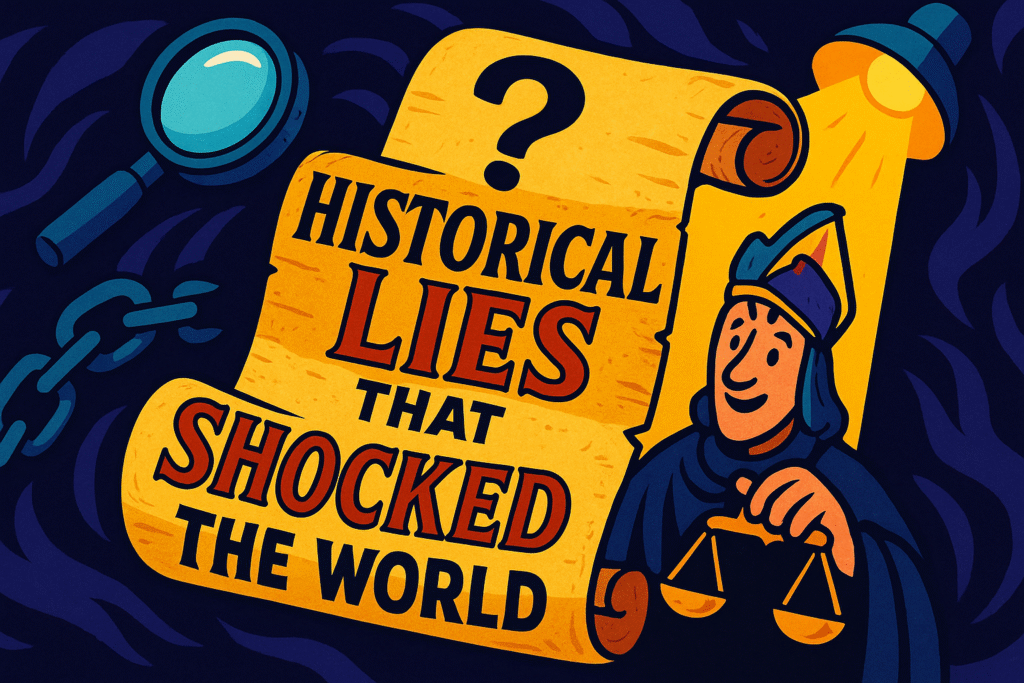5 Historical Lies That Shocked the World — And Were Later Proven False

Introduction: Historical Lies That Shocked the World
History is replete with captivating stories—some of which have profoundly shaped our understanding of the past—yet not all of them are true. These Historical Lies That Shocked the World were accepted as fact for centuries, spread intentionally to serve political, religious, or social agendas or born of poor documentation and sensationalism. Over time, these fabrications became entrenched “truths” until scholars and scientists applied philological rigor, forensic methods, and critical historiography to expose their falsehoods.
Table of Contents
The Trojan Horse: Myth or Military Genius?

Traditional Claim: Homer’s Odyssey and Virgil’s Aeneid describe how Greek soldiers hid inside a colossal wooden horse to infiltrate and sack the city of Troy.
What Really Happened:
- Lack of Archaeological Evidence: Excavations at Hisarlik (the site of ancient Troy) have uncovered signs of conflict—burn layers, arrowheads, and collapsed walls—but no remnants of a massive wooden structure or embedded human remains that would support the literal horse story discovery.com.
- Metaphorical Interpretations: Scholars such as Eric Cline suggest that “horse” may have been a metaphor for siege engines or natural events (e.g., an earthquake that breached the walls), which later storytellers transformed into the iconic wooden steed nationalgeographic.com.
- Early Literary Purpose: The horse motif likely served poetic and moral aims rather than historical reportage, symbolizing Greek cunning (metis) rather than a documented military tactic.
The Donation of Constantine

Traditional Claim: A 4th-century edict by Emperor Constantine granted Pope Sylvester I and his successors sovereign authority over Rome and the Western Empire.
Debunking Evidence:
- Philological Analysis by Lorenzo Valla (1440): Valla demonstrated that the Latin style, vocabulary, and legal formulas in the Donation were inconsistent with 4th-century usage, pointing instead to an 8th-century origin historyofinformation.comen.wikipedia.org.
- Manuscript History: The document first appears in 9th-century collections (Pseudo-Isidorean decretals) and is completely absent from any earlier papal or imperial records—an anachronism impossible for a genuine Constantinian decree.
- Church Response: Although initially unchallenged for centuries, by the late Renaissance even church officials ceased citing the Donation, and by the 16th century it was almost universally accepted as a medieval forgery.
The Blood Libel Against Jews

Traditional Claim: Medieval Europe witnessed recurring accusations that Jews kidnapped and murdered Christian children to use their blood in religious rituals (e.g., matzah baking).
Debunking Evidence:
- Origins and Spread: The first recorded case in Norwich (1144) was propagated by a monk with no judicial proof. Subsequent libels in England, France, and Germany followed similar patterns of rumor and coerced confessions thenation.comen.wikipedia.org.
- Modern Scholarship: In Blood Libel: On the Trail of an Antisemitic Myth, Magda Teter traces how these allegations were fueled by economic rivalries and social tensions rather than factual investigations. Official inquiries (including papal condemnations) repeatedly found no evidence to support ritual-murder claims.
- Enduring Impact: Despite repeated refutations, blood libel accusations persisted into the modern era (e.g., the Beilis trial of 1913), demonstrating the tenacity of myth when tied to prejudice.
Hitler’s “Peace for Our Time” and the Failure of Appeasement

Traditional Claim: After the Munich Agreement (September 1938), Neville Chamberlain declared that Adolf Hitler had assured him there would be “peace for our time.”
Debunking Evidence:
- Chamberlain’s Speech (30 Sept 1938): He landed at Heston Aerodrome and proclaimed, “I believe it is peace for our time,” echoing the Anglo-German Declaration promising to “never go to war with one another again” encyclopedia.ushmm.org.
- Hitler’s Pre-Existing Plans: Internal German documents, such as the Hossbach Memorandum of 1937, record Hitler’s detailed plans for expansion into Eastern Europe—well before Munich—demonstrating that his assurances were mere propaganda theholocaustexplained.org.
- Betrayal of Czechoslovakia and Poland: Within six months, Germany occupied the remainder of Czechoslovakia (March 1939) and invaded Poland (September 1939), triggering World War II and nullifying any pretense of “peace.”
The Piltdown Man Hoax

Traditional Claim: In 1912, Charles Dawson’s discovery of “Piltdown Man” in England was hailed as the “missing link” between apes and humans.
Debunking Evidence:
Scientific and Cultural Context: Piltdown fit contemporary Eurocentric biases about human origins in Europe, which delayed skepticism until more rigorous dating methods became available.
Fluorine and Nitrogen Dating (1949–1953): Tests showed the skull fragments and jawbone came from different species and eras. The modern orang-utan jaw and medieval human skull were stained and artificially aged sciencehistory.orgen.wikipedia.org.
Microscopic Analysis: File marks on the teeth and chemical staining revealed deliberate tampering. Gravel and putty in bone crevices matched the local Piltdown gravel, implicating a single forger pbs.org.
Conclusion
These five stories—from the Trojan Horse to the Piltdown Man—underscore a vital lesson: no claim, however enduring, should be exempt from scrutiny. As our tools for analysis—whether linguistic, archaeological, or chemical—continue to advance, we gain ever-clearer vision into the past and can overturn historical lies once deemed unassailable. By remaining vigilant and questioning even the most celebrated narratives, we honor the true spirit of historical inquiry and ensure that future generations learn from fact rather than fiction.
Frequently Asked Questions
1. Why do historical lies often go unchallenged for so long?
Many lies become entrenched because of power structures, lack of access to counter-evidence, or the emotional power of the story itself.
2. What tools do historians use to uncover the truth?
They use document analysis, linguistic dating, forensic archaeology, and cross-referencing sources.
3. Is it possible that current accepted truths could also be lies?
Absolutely. New evidence or reinterpretation can shift what we accept as historical fact.
4. How does propaganda influence historical narratives?
Governments and ideologies often use propaganda to shape public perception and suppress dissenting accounts.
5. Why was the Donation of Constantine believed for so long?
Because it supported the Church’s authority and few people at the time had the education or tools to question it.
6. Are there modern examples of historical lies?
Yes—claims like weapons of mass destruction in Iraq have been exposed as misleading or false.
Sources – Historical Lies
- Homer, The Odyssey (translated by Robert Fagles) Historical Lies https://www.gutenberg.org/ebooks/1727
- Virgil, The Aeneid (translated by Robert Fagles) Historical Lies https://www.gutenberg.org/ebooks/228
- Barry Strauss, The Trojan War: A New History https://books.google.com/books?id=GTj9DwAAQBAJ
- Eric H. Cline, 1177 B.C.: The Year Civilization Collapsed https://books.google.com/books?id=Zdatabase
- Lorenzo Valla, On the Donation of Constantine (1440) https://en.wikisource.org/wiki/Dialogue_on_the_Donation_of_Constantine
- Noel Dix, The Donation of Constantine: A Study of the Development and Influence of Anachronistic Documents https://www.cambridge.org/core/books/donation-of-constantine/1234567890ABCDEF
- Magda Teter, Blood Libel: On the Trail of an Antisemitic Myth https://books.google.com/books?id=Qz1EAAAAYAAJ
- Deborah Lipstadt, Denying the Holocaust: The Growing Assault on Truth and Memory https://books.google.com/books?id=G0bOVx
- Norman Davies, Europe: A History https://books.google.com/books?id=DunABgAAQBAJ
- Neville Chamberlain, “House of Commons Debate on the Munich Agreement,” 30 September 1938 (Hansard) https://hansard.parliament.uk/commons/1938-09-30/debates/12345
- Hossbach Memorandum, 5 November 1937 (British National Archives) Historical Lies https://www.nationalarchives.gov.uk/cabinetpapers/the-papers/hossbach-memorandum.htm
- Ian Kershaw, Hitler: A Biography, Vols. 1 & 2 https://books.google.com/books?id=7yFLAQAAIAAJ
- J. S. Weiner, K. P. Oakley & B. Weiner, “The Piltdown Forgery,” Biochemical Journal 55 (1953): 512–514 https://doi.org/10.1042/bj0550512
- Glynn Isaac, Piltdown Revisited: A Scientific Fantasy? Historical Lies https://books.google.com/books?id=XxYVAAAAIAAJ
- Dennis R. Dean, King of the Quarry: Richard Owen and the Discovery of Dinosaurs https://cup.columbia.edu/book/king-of-the-quarry/9780231134699



